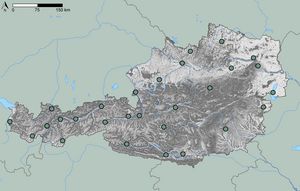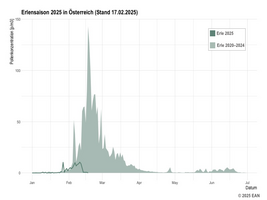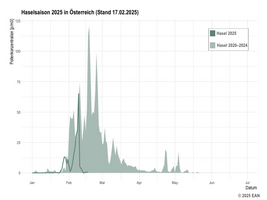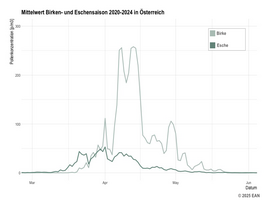First impressions of the 2025 pollen season and preview for the coming months
First impressions
The pollen season actually begins in some regions of Austria around Christmas time. This is when the purple alders(Alnus x spaethii), which are often planted as park and avenue trees, are ready to flower. These trees are hybrids, i.e. crosses of two alder species, the Japanesealder(Alnus japonica) and the Caucasianalder(Alnus subcordata), which, unlike many other members of the Alnus genus, begins to flower at the end of December. However, as the purple alder is less widespread than the native species such as gray alder(Alnusincana), black alder(Alnus glutinosa) or green alder(Alnus viridis), pollen concentrations in the air that can lead to allergic reactions are generally only to be expected in the immediate vicinity of larger stands.
After the purple alder blossomed, hazel and alder pollen allergy sufferers were able to enjoy a brief period of relief, which lasted until the second half of January in most parts of the country. After that, the first concentrations of alder (Fig. 2) and hazel pollen (Fig. 3) were registered at the measuring points in Austria (Fig. 1), which could already lead to minor allergic symptoms. As Fig. 2-3 shows, these pollen concentrations were reached only slightly earlier than the 5-year average. It should also be noted that the diagrams shown here represent an average value across all active pollen traps in Austria. It is therefore quite possible that only one of the two pollen types was measured in relevant concentrations at individual locations. The effects of the rather unsettled weather at the beginning of February, which did not allow the pollen count to really get going, are also clearly visible. The concentrations of both alder (Fig. 2) and hazel (Fig. 3) remained slightly below the long-term average in the first week of February. It remains to be seen how the situation will develop over the course of the season. Based on phenological observations of the catkins of both species and historical data, it can be assumed that a rapid increase in pollen concentrations and the associated pollution can be expected in the coming weeks if the weather conditions are right. Due to the great similarity of the main allergens of hazel (Cor a1) and alder (Aln g1), many allergy sufferers who are sensitized to one of the two proteins may also experience allergy symptoms on contact with the other due to a cross-reaction. So if you are allergic to one of the two proteins, you should also avoid the other as a precaution. In the case of native alder species, this would usually be riparian forests or other locations near waterand in the case of hazel, the edges and undergrowth of deciduous forests.
In most parts of the country, the main exposure phase for early bloomers ends between the end of March and the beginning of April. After that, however, both types of pollen can reappear in the pollen spectrum and lead to allergic reactions again. The first is green alder(Alnus viridis), which usually releases pollen between the end of May and the end of June in its alpine distribution area (Fig. 2), and the second is corkscrew hazel(Corylus avellana 'Contorta'), which flowers as an ornamental plant in some gardens between the end of April and the beginning of May (Fig. 3).
Preview of the coming months
As already described, the peak of this year's hazel and alder season is expected to be reached in the next few weeks. If the flowering process is in line with the long-term average, the main stress period is expected to end between the end of March and the beginning of April, depending on the province and altitude. This means that the flowering of these two genera overlaps with that of another representative of the birch family (Betulaceae), namely the eponymous birch(Betula spp.), and with the flowering of the commonash(Fraxinus excelsior), which belongs to the olive family (Oleaceae).
As Fig. 4 shows, the ash blossom in Austria begins somewhat earlier than the birch blossom and usually causes the most intensive exposure between mid-March and mid-April on a 5-year average. The main allergen (Fra e1) can be classified as relevant, but sensitization often remains undetected as many other types of pollen are also present in the ambient air during the ash blossom.
These include birch pollen, for example, which usually peaks in Austria in the first half of April. The main allergen (Bet v1) is classified as highly allergenic and causes intense stress for many allergy sufferers. Many people suffer from allergy symptoms during the birch pollen season, mainly due to cross-reactivity with hazel, alder and hornbeam pollen, but also with foods such as apples, stone fruit, nuts and carrots.
It is still too early to make more precise statements about the start of the birch pollen season. The forecasting models of the Austrian Pollen Information Service Association provide initial data on flowering readiness from March onwards. However, these still show a wide range of fluctuation, especially at the beginning, and only become more accurate as the start of flowering approaches. The best way to stay up to date is to use the Pollen+ app or the polleninformation.at website. There you can document your symptoms in the pollen diary, receive regular information about the expected exposure and other useful information about pollen allergies.
Go to news overview




